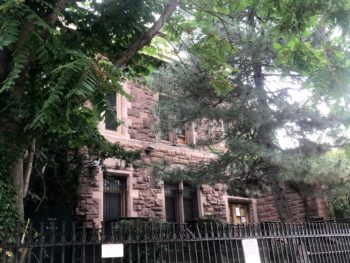
Dean Sage Mansion. Image Credit: CityLand
The owners of the Dean Sage Mansion in Crown Heights North Historic District sought to build addition to the 1870’s mansion. In the mid-nineteenth century the Crown Heights neighborhood of Brooklyn underwent suburban development of freestanding villas. Today, only a few of the Sturgis villas remain, one of which is the Dean Sage Mansion at 839 St. Mark’s Avenue, a rare High Gothic style mansion built in 1870 by architect Russell Sturgis. The Mansion, which gained additional wings in the 1930s, is one of only a few of Sturgis’s designs in New York today.
In 2007 the Landmarks Preservation Commission designated the Crown Heights North Historic District, reporting that the neighborhood is one of Brooklyn’s most architecturally distinguished areas. While Landmarks did not specifically designate either the Dean Sage Mansion or its gardens as landmarks, the 2007 historic district designation report characterizes the Dean Sage Mansion as “a freestanding house” and “although the house was altered after the 1930s with the addition of a single-story, stoneveneered bay at the eastern end of its main façade, and the construction of a large tan-brick rear addition, the original house remains as a well-preserved reminder of northwestern Crown Heights’ suburban years.”
The Institute for Community Living has owned the Dean Sage Mansion since 1998. The Institute, a not-for-profit organization, provides social services for adults with mental disabilities. In 2015, the Institute planned to expand the mansion to accommodate its programing and create affordable housing. The Institute would demolish the Mansion’s rear addition, restore the Mansion’s residence, and construct a five-and-a-half story L-shaped building on a portion of the Mansion’s parterre garden.
In June 2017, Landmarks approved the Institute’s permit application and issued a Certificate of Appropriateness. Landmarks found that the Institute’s proposed construction would be consistent with the aesthetic of the original building because the 1930 addition had taken away the Mansion’s freestanding original design. Landmarks stated, “the Commission found that the existing 1930’s addition does not relate to the historic mansion in terms of style, scale, or materials and is not given an architectural style in the designation report, therefore its demolition will not detract from the special historic and architectural character of the mansion or the Crown Heights North Historic District; that the demolition of the existing addition will allow for the restoration of the historic facades of the mansion, allowing for the perception of the building as a free-standing structure.”
The St. Mark’s Block Association and the Crown Heights North Association filed an Article 78 proceeding against Landmarks arguing that Landmarks failed to consider the preservation of architectural aesthetics and beauty of the community. Kings County Supreme Court Justice Katherine Levine agreed with the Block Association, ruled that Landmarks’ issuance of the permit was arbitrary and capricious and voided the certificate. Judge Levine found that Landmarks ignored the adverse impact that new building would have on the Mansion’s architectural aesthetic.
Judge Levine believed that the Institute’s plan would obliterate the freestanding nature of the Mansion and would eliminate two-thirds of its parterre garden, and that the garden was integral to the architectural design of the Mansion. Additionally, Judge Levine ruled that Landmarks unlawfully deferred to the Institute’s social and economic purposes for expanding its mission and providing low-income housing. Under the Landmarks Law, the Landmarks Commission can only assess applications by considering aesthetic, historical, and architectural values and significance, architectural style, design, arrangement, texture, material and color.
As of January 2020, the case is now on appeal.
(CIT) Hilbertz v. City of New York, 98 N.Y.S.3d 776 (Kings County 2019).
By: Laine Vitkevich (Laine is a CityLaw Intern and New York Law School student, Class of 2020.)


ICL has appealed the decision & the Community is defending against the appeal. See Appellate Dev. 2d Dept Docket Nos. 2019-06752, 2019-06753, 2019-06755
The ICL Appellants and the City Appellants have argued on appeal that the Court improperly substituted its opinion for the judgment of the NYC Landmark Preservation Commission, which is a body comprised of experts who are legally empowered to make that judgment. Appellants further argued that the Court’s decision relies upon precedent that was specifically reversed by the decision of the New York State Court of Appeals in Save America’s Clocks v. City of New York, 33 N.Y.3d 198, 2019 N.Y. Slip. Op. 02385 (2019), reargument denied, 33 N.Y.3d 1054, 2019 N.Y. Slip. Op. 72548 (June 13, 2019).